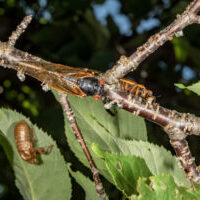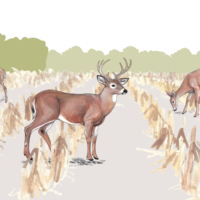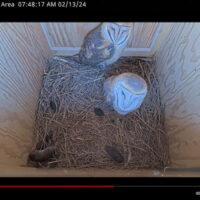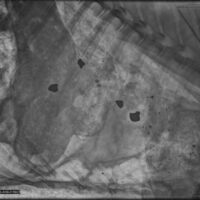 Purdue University - Extension - Forestry and Natural Resources
Purdue University - Extension - Forestry and Natural Resources
Got Nature? Blog
It is in the vested interest of both humans and wildlife to reduce potential traffic collisions. Researchers in the Purdue Department of Forestry and Natural Resources and with the Indiana Department of Natural Resources looked at one possible option to do so in a five-year study involving the development and use of deer-reduction zones, areas where targeted recreational hunting was utilized to reduce animal-vehicle collisions.
The interdisciplinary research group recently published its findings in Science of the Total Environment. Along with lead author Zackary Delisle, a 2023 PhD alumnus, and Dr. Rob Swihart, professor emeritus of wildlife ecology with Purdue FNR, the research team included Carson Reeling, an associate professor with the Purdue Department of Agricultural Economics, Indiana state deer project leader Joe Caudell and 2018 PhD alumna Emily McCallen, a wildlife biometrician with the Indiana DNR Division of Fish and Wildlife.

“The initial goal for this research was to test a method for decreasing deer-vehicle collisions (DVCs) throughout Indiana,” Delisle said. “DVCs are quite frequent in Indiana. From 2003 to 2022, there were more than 300,000 reported DVCs in Indiana, with estimated costs to society of more than $2.5 billion dollars! Therefore, discovering a way to decrease the number of DVCs is important for deer management in Indiana.”
Researchers initially studied the activity of deer in delineated research units across the state, the findings of which are available in an article titled “Deer activity levels and patterns vary along gradients of food availability and anthropogenic development,” published in Nature’s Scientific Reports. The study examined the relationships between animal activity and the availability and quality of food, proximity to human development and other factors, utilizing trail cameras to sample more than 1,000 unique locations during the winters of 2019, 2020 and 2021.
“In that paper we found that deer in the northeast region of Indiana (what we called RMU 9) spend more of the day active than in other regions we studied,” Swihart explained. “Because traffic volume also tends to be higher during the day, deer in this region presumably are more likely to collide with a car. In the northeast region, we specifically estimated deer to be more active in the morning and less active at night, unlike the other regions.”
The publication summarizes the results:
“If animals either are active during a greater fraction of each day or shift their activity to coincide with periods of peak vehicular traffic volume, the chances of animals and vehicles colliding on the landscape likely will increase. In our study, we documented in RMU 9 the highest regional activity levels and a pattern characterized by a greater fraction of activity during the morning rush hours. Under such conditions, accidents involving collisions between motorists and deer might be expected. Indeed, deer-vehicle collisions occur at a rate 1.98 times higher in RMU 9 compared to RMU 3 and 4. Therefore, quantitative examinations of the relationships between characteristics of activity distributions and deer-vehicle collisions may help future management planning to reduce collisions. If positive relationships are found, incentivizing humans to hunt deer in close proximity to roadways may reduce occurrence of deer-vehicle collisions by causing deer to shift to nocturnal activity patterns, reduce movement rates, or select areas further from roads.”
Based on the results of the initial study, researchers tested how well policies designed to increase human hunting of deer (longer hunting seasons and increased harvest limits) reduced deer-vehicle collisions along 618 kilometers (or 384 miles) of high-risk roadways, or those in the upper 99th percentile in terms of DVCs.
Of the 51 selected roadways covering 949 km, relaxed hunting regulations were implemented among 15 of them, designated as treatment deer reduction zones (DRZs), while 36 roadways were left as is, designated as control DRZs. All parcels of land within 0.8 km of the high-risk road were included as part of the deer-reduction zone.
A unique license was developed specifically for hunters pursuing deer within treatment DRZs, with a cost ranging from $24 to $240 depending on the year and a hunter’s residence status.
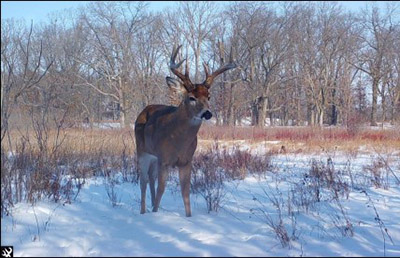
Findings from the study show both a decrease in number of deer-vehicle collisions and the amount of economic damages from those accidents, as well as increased revenue for the local wildlife management agency. The publication details:
“We estimated a strong interaction between treatment type and initiation of DRZs. Deer reduction zones decreased DVCs by a predicted 21.12 % along 618 km of high-risk roadways and prevented an estimated 69.6 DVCs from 2018 to 2022. Deer reduction zones saved up to $653,756 in economic damages to society during the 5-y treatment period. This total savings included $483,983 in estimated vehicular damage, $123,180 in avoided fatalities, and $46,593 in avoided injuries. The DRZs brought in $206,268 in revenue from license sales.”
Delisle said the success of the study lies not only in the fact that the methods tested worked in reducing DVCs, but also in the potential supplemental revenue for wildlife agencies, which are often underfunded and overwhelmed.
“Our findings are unique in that most previously tested methods for reducing DVCs cost a lot of money to implement, but our method actually generated revenue from hunting licenses,” Delisle noted. “We also found a way to decrease DVCs, which is massive in terms of the cost savings to society and the potential prevention of human injuries and fatalities, which unfortunately do occur in DVCs. In addition to nontraditional stakeholders, which could be defined as anyone driving a car in Indiana, our method for reducing DVCs also gives traditional stakeholders (i.e., hunters) more opportunities to harvest deer in certain areas of Indiana. Needless to say, we were very pleased with these findings because it was the first test of such methods across very large scales germane to state wildlife management.
“Knowing that we were able to figure out that increased recreational hunting worked at reducing DVCs feels special because we may have prevented someone from getting seriously hurt or killed. Personally, being able to analyze data on an experiment like that this has the potential to really influence how deer are managed in Indiana as well as help people (prevention of costs, human injuries and human fatalities) was really cool and I am thankful to have been given the opportunity to work on this project with my coauthors.”
Caudell believes that there is a future in applying these research findings beyond the original test areas and said the Indiana DNR is already working to do so.
“Now that we have evidence that this method can reduce deer vehicle collisions, the DNR is in the process of adding these deer reduction zones to our rules so that hunters will continue to use these areas over time,” Caudell said. “DNR’s deer biologists will also look for other areas around the state where we would expect this season to be effective and possibly expand the reduction zones to new areas around the state.”
Although the study shows that increased human hunting decreased the number of deer-vehicle collisions, more work must be done to explain the connection between hunting and a reduced number of accidents.
Delisle explains that the group has two main hypotheses: (1) the population density of deer may be reduced before most DVCs occur (mid-October to December), hence, there are fewer deer on the landscape to collide with vehicles; and (2) there is a behavioral change in deer where deer avoid areas with more human hunters (again, behavioral change before mid-October to December).
“Ultimately, although the findings of this project were pretty neat, more research is needed to discover what ecological mechanism is driving the reduction in DVCs,” Delisle noted. “As is typical in the awesome process of science, someone else will need to make that discovery.”
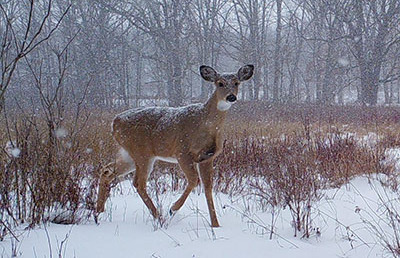
Beyond establishing the connection between hunting and reduced deer-vehicle collisions, another more specific hypothesis, related to No. 2 above, involves expanding the research to examine collision rates with bucks and does.
“Other researchers have shown that deer adjust their activity to avoid risky times and risky places, with greater tolerance for risk during breeding seasons (for bucks) and fawn-rearing seasons (for does),” Swihart said. “So, a prediction that could be tested in future research is that deer-reduction zone policies, which do not include fawning season, should be more effective in reducing deer-vehicle collisions with does than with bucks because does will be more likely to adjust their activity in response to greater hunting risk during fall/winter.”
To view this article along with other news and stories posted on the Purdue Forestry and Natural Resources website view: Researchers Study Deer-Vehicle Collision Reduction Method.
Resources:
Ask an Expert, Playlist, Purdue Extension – FNR YouTube Channel
Wildlife Habitat Hint, Playlist
Woodland Stewardship for Landowners: Managing Deer Damage to Young Trees, Purdue Extension-FNR YouTube Channel
Introduction to White-tailed Deer Impacts on Indiana Woodlands, Got Nature? Blog & The Education Store
Purdue Extension Pond and Wildlife Management
Understanding White-tailed Deer and Their Impact on Indiana Woodlands, The Education Store
Monitoring White-tailed Deer and Their Impact on Indiana Woodlands, The Education Store
Managing White-tailed Deer Impacts on Indiana Woodlands, The Education Store
How to Build a Plastic Mesh Deer Exclusion Fence, The Education Store
Managing Your Woods for White-Tailed Deer, The Education Store
Deer Harvest Data Collection, Got Nature? Blog, Purdue Extension – FNR
Handling Harvested Deer Ask an Expert? video, Purdue Extension – FNR YouTube Channel
Subscribe to Purdue Extension-Forestry & Natural Resources YouTube Channel, Wildlife Playlist
A Woodland Management Moment – Deer Fencing, Purdue Extension – FNR YouTube Video
Wendy Mayer, FNR Communications Coordinator
Purdue University Department of Forestry and Natural Resources
MyDNR, Indiana’s Outdoor Newsletter: Indiana DNR has confirmed the state’s first positive case of chronic wasting disease (CWD) in LaGrange County. CWD is a fatal infectious disease, caused by a misfolded prion, that affects the nervous system in white-tailed deer. It can spread from deer-to-deer contact, bodily fluids, or through contaminated environments.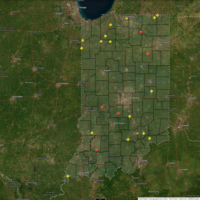
There have been no reported cases of CWD infection in people, but the Centers for Disease Control and Prevention (CDC) recommends that hunters strongly consider having deer tested before eating the meat. The CDC also recommends not eating meat from an animal that tests positive for CWD.
CWD has been detected in 33 states including the four bordering Indiana (Ohio, Michigan, Illinois, and Kentucky). Because CWD had been detected in Michigan near the Indiana border, a detection in LaGrange County was likely.
If you see any sick or dead wildlife, deer or otherwise, please report your observations on the DNR: Sick or Dead Wildlife Reporting page.
For more information visit DNR: Chronic Wasting Disease (CWD).
To subscribe to the newsletter visit MyDNR Email Newsletter.
Resources:
Chronic Wasting Disease, USDA Animal and Plant Health Inspection Service (APHIS)
Bovine Tuberculosis in Wild White-tailed Deer, The Education Store, Purdue Extension resource center
Hunting & Trapping, Indiana Department of Natural Resources (DNR)
Designing Hardwood Tree Plantings for Wildlife , The Education Store
Wildlife Habitat Hint: Trail Camera Tips and Tricks, Got Nature? Blog
How to Score Your White-tailed Deer, video, The Education Store
White-Tailed Deer Post Harvest Collection, video, The Education Store
Age Determination in White-tailed Deer, video, The Education Store
How to Build a Plastic Mesh Deer Exclusion Fence, The Education Store
Ask the Expert: Hardwood Ecosystem Experiment – Birds and Salamander Research, Purdue Extension – FNR
A Template for Your Wildlife Habitat Management Plan, The Education Store
Managing Your Woods for White-Tailed Deer, The Education Store
Deer Impact Toolbox, Got Nature? blog, Purdue Extension-Forestry and Natural Resources (FNR)
Indiana Department of Natural Resources
Purdue Landscape Report: Hoosiers are in for a special treat this spring. If you have lived in Indiana for more than a year, you have probably grown accustomed to the singing of cicadas in the later days of summer. However, in some years, cicadas will emerge in the spring. This occurred in 2021 when most of the state was inundated in periodical cicadas as Brood X emerged from their 17-year development. This year, two broods will emerge concurrently: Brood XIII and Brood XIX. Brood XIII is a 17-year cicada, while Brood XIX is a 13-year cicada. The emergence of these two broods isn’t unusual, but this year is special because they will asemerge at the same time. Their schedules haven’t aligned for over two hundred years! The last time these two cicada songs were heard together, Thomas Jefferson was in the White House. While this may sound like Indiana is about to be covered in cicadas, there are a few facts that may change your expectations.
There are two types of cicadas in the Midwest: annual cicadas and periodical cicadas. Annual cicadas, as the name implies, are seen each year. They normally spend two to five years underground, but there are enough of them that we see them emerge each year. Annual cicadas emerge individually, not as a group, and we see them towards the end of the summer, thus their other common name, “dog day cicadas”. Periodical cicadas have a much different life cycle. They remain in the ground as nymphs for either thirteen or seventeen years, feeding on the roots of the trees they will eventually climb. Around April, the broods will emerge together using a combination of temperature and their own internal clock. Both types of cicadas feed on deciduous trees and tend to inhabit areas where eggs were laid during previous emergences, giving them a low likelihood of moving to new areas. Annual cicadas are green with black eyes, and periodical cicadas have dark-colored bodies with red eyes and orange legs, making it easy to differentiate them as we enter the early summer and both types are present.
The term “brood” cicada biology is referring to a group of cicadas that share the same developmental time and the same physical area. A brood will often contain several different species, though they will all belong to the genus Magicicada. Cicadas in a brood do not need to be genetically related to each other. Some broods are very small and cover a small area, whereas others can cover a significant portion of the Midwest. For example, Brood XII, a brood of 17-year cicadas, last appeared in 2023 and has only been detected in Allen and Orange counties. On the other hand, Brood X, also known as the Great Eastern Brood, covers the entirety of Indiana and several other states. Brood XIII and Brood XIX both cover several states, but they will have very little overlap in Indiana. Only eight western counties, between Posey and Jasper counties, will experience Brood XIX, and three northern counties (Lake, LaPorte, and Porter) will see Brood XIII. Nowhere in Indiana do the broods overlap. Essentially, while there will be a lot of cicadas emerging all at once, the lack of overlap will mean this emergence will be notable, but nothing compared to the Brood X emergence a few years ago.
To view this full article and other Purdue Landscape Report articles, please visit Purdue Landscape Report.
Subscribe and receive the newsletter: Purdue Landscape Report Newsletter.
Resources:
Periodical Cicadas, Indiana Department of Natural Resources, Division of Entomology
Billions of Cicadas Are Coming This Spring; What Does That Mean for Wildlife?, Got Nature? Blog, Purdue Extension-Forestry and Natural Resources (FNR)
17 Ways to Make the Most of the 17-year Cicada Emergence, Purdue College of Agriculture
Ask an Expert: Cicada Emergence Video, Got Nature? Blog, Purdue Extension-FNR
Periodical Cicada in Indiana, The Education Store, Purdue Extension resource center
Cicada Killers, The Education Store
Purdue Cicada Tracker, Purdue Extension-Master Gardener Program
Cicada, Youth and Entomology, Purdue Extension
Indiana Department of Entomology and Plant Pathology
Alicia Kelley, Cooperative Agricultural Pest Survey (CAPS) Coordinator
Purdue Extension – Entomology
Bob Bruner, Exotic Forest Pest Specialist
Purdue Extension – Entomology
White-tailed deer are an important part of our Hoosier natural areas and a true conservation success story. Once extirpated from Indiana, deer now thrive in all 92 counties.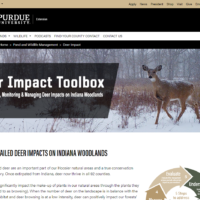
Deer can significantly impact the make-up of plants in our natural areas through the plants they eat (referred to as browsing). When the number of deer on the landscape is in balance with the available habitat and deer browsing is at a low intensity, deer can positively impact our forests’ plant diversity. When deer are overabundant, their browsing can impact forests in a variety of negative ways.
5 Steps to address deer impacts to Indiana Woodlands:
Understanding
Understand how deer impact Indiana’s forest ecosystems.
Identify
Identify signs and symptoms of deer impact in your woodland.
Monitor
Monitor how deer are impacting your woodland over time.
Manage
Decide how to manage deer and their impact on your woodland.
Evaluate
Evaluate if the management actions you took reduced deer impact on your woodland.
Check out the new Deer Impact Toolbox website for publications and more details to discover the steps landowners and land managers can take to understand, monitoring, and manage deer impacts to Indiana’s forests.
Don’t miss the videos: Monitoring Deer Impacts on Indiana Forests: Ten-Tallest Method and Monitoring Deer Impacts on Indiana Forests: Accessing Vegetation Impacts for Deer (AVID) Plots.
Check out the College of Agriculture news article to learn more: Deer Impact Toolbox provides guidance for Indiana forest landowners and managers.
Resources:
Purdue Extension Pond and Wildlife Management
Understanding White-tailed Deer and Their Impact on Indiana Woodlands, The Education Store
Monitoring White-tailed Deer and Their Impact on Indiana Woodlands, The Education Store
Managing White-tailed Deer Impacts on Indiana Woodlands, The Education Store
Ask an Expert: Wildlife Food Plots, video, Purdue Extension – FNR YouTube Channel
How to Build a Plastic Mesh Deer Exclusion Fence, The Education Store
Managing Your Woods for White-Tailed Deer, The Education Store
Bovine Tuberculosis in Wild White-tailed Deer, The Education Store
Handling Harvested Game: Episode 1, Field Dressing, video, Purdue Extension – FNR YouTube Channel
Deer Harvest Data Collection, Got Nature? Blog, Purdue Extension – FNR
How to Score Your White-tailed Deer, video, The Education Store, Purdue Extension Resource Center
White-Tailed Deer Post Harvest Collection, video, The Education Store
Age Determination in White-tailed Deer, video, The Education Store
Handling Harvested Deer Ask an Expert? video, Purdue Extension – FNR YouTube Channel
Subscribe to Purdue Extension-Forestry & Natural Resources YouTube Channel, Wildlife Playlist
Jarred Brooke, Wildlife Extension Specialist
Purdue Department of Forestry and Natural Resources
Wild Bulletin, Indiana Department of Natural Resources (DNR) Fish and Wildlife: Researchers at Purdue University are studying the willingness of hunters and nonhunters to help reduce the spread of chronic wasting disease (CWD) in white-tailed deer. CWD is a fatal neurological disease affecting deer and is caused by an infective protein (prion) that damages the animal’s nervous system. CWD is contagious to deer and can spread through deer-to-deer contact or through contaminated environments. To date, CWD has not been detected in Indiana. No cases of CWD have been recorded in humans.
Researchers at Purdue University are seeking volunteers to participate in this research study. Information collected may help inform Indiana DNR’s response to CWD. Participants will answer online survey questions and use a web app that shows how CWD may spread. The activity and survey questions take about 30 minutes to complete. The study is open to everyone 18 years or older. All that is required to participate is a computer or tablet. Follow this link to Purdue’s website to participate in the study.
Chronic wasting disease (CWD) is a fatal neurological disease affecting white-tailed deer, mule deer, elk, and moose. It is a member of a group of diseases called transmissible spongiform encephalopathies (TSEs), or prion diseases. For more information about this disease visit Indiana Department of Natural Resources – Chronic Wasting Disease (CWD).
For questions about this study, please email the research team at cwdwebapp@purdue.edu and place in the subject line: “Web App Use and Intention to Reduce Chronic Wasting Disease Spread; Principal Investigator – Dr. Patrick Zollner; IRB Number – IRB-2023-1039″.
To get started, please visit the CWD Web App.
Resources:
Dr. Pat Zollner, Professor of Quantitative Ecology, Purdue Forestry and Natural Resources
Bovine Tuberculosis in Wild White-tailed Deer, The Education Store, Purdue Extension resource center
Designing Hardwood Tree Plantings for Wildlife , The Education Store
Wildlife Habitat Hint: Trail Camera Tips and Tricks, Got Nature? Blog
Hunting Guide for 2023-2024, Indiana Department of Natural Resources
How to Score Your White-tailed Deer, video, The Education Store
White-Tailed Deer Post Harvest Collection, video, The Education Store
Age Determination in White-tailed Deer, video, The Education Store
How to Build a Plastic Mesh Deer Exclusion Fence, The Education Store
Forest Management for Reptiles and Amphibians: A Technical Guide for the Midwest, The Education Store
Ask the Expert: Hardwood Ecosystem Experiment – Birds and Salamander Research, Purdue Extension – FNR
A Template for Your Wildlife Habitat Management Plan, The Education Store
Managing Your Woods for White-Tailed Deer, The Education Store
Indiana Department of Natural Resources
MyDNR, Indiana’s Outdoor Newsletter: As spring has sprung, so has new wildlife. It may be tempting to cuddle cute, young wildlife, but it’s important to always assess the situation from a safe distance.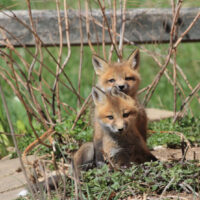
Young wildlife’s best chance of survival is with their mother, and your support can often unintentionally harm wildlife if that support is not needed. If young wildlife have fallen out of a den or nest, you can return them to their home and then leave the area. It is common for a mother to leave her young for long periods of time to forage for her and her young, so don’t linger around wildlife or their homes too long. Doing this can dissuade a mother from returning or alert predators to the young.
If you’re uncertain whether wildlife need assistance, contact a wildlife rehabilitator before picking up wildlife. If wildlife truly need assistance, they must be turned over to a permitted wildlife rehabilitator within 24 hours. Find a list of permitted wildlife rehabilitators on our website.
To learn more, please visit DNR: Fish & Wildlife Resources.
To subscribe to the newsletter visit MyDNR Email Newsletter.
Resources:
Designing Hardwood Tree Plantings for Wildlife – The Education Store
ID That Tree – YouTube Playlist
Forest Management for Reptiles and Amphibians: A Technical Guide for the Midwest, The Education Store
Ask the Expert: Hardwood Ecosystem Experiment – Birds and Salamander Research, Purdue Extension – FNR
A Template for Your Wildlife Habitat Management Plan, The Education Store
Managing Your Woods for White-Tailed Deer, The Education Store
Woodland Stewardship for Landowners, Playlist, Purdue Extension – FNR YouTube channel
Creating a Wildlife Habitat Management Plan for Landowners, The Education Store, Purdue Extension’s resource center
A Template for Your Wildlife Habitat Management Plan, The Education Store
Birds and Residential Window Strikes: Tips for Prevention, The Education Store, Purdue Extension resource center
Managing Woodlands for Birds Video, Purdue Extension-Forestry and Natural Resources (FNR) YouTube Channel
Developing a Wildlife Habitat Management Plan, The Education Store
The Nature of Teaching, YouTube channel
Nature of Teaching: Common Mammals of Indiana, The Education Store
Subscribe to Purdue Extension-Forestry & Natural Resources YouTube Channel, Wildlife Playlist
Indiana Department of Natural Resources
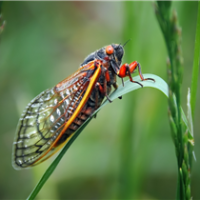 WRTV, Indianapolis News and Headlines: WEST LAFAYETTE — Elizabeth Long loves bugs.
WRTV, Indianapolis News and Headlines: WEST LAFAYETTE — Elizabeth Long loves bugs.
And she wants you to know that this summer is going to be huge for bug lovers, thanks to the emergence of two special broods of cicadas, which hasn’t happened in more than two centuries.
“That’s really, really exciting for these periodical cicadas, these two broods that are going to be emerging this year,” said Long, a Purdue University assistant professor of entomology.
“The big deal is the fact that they will be emerging in synchrony for the first time (since 1803). It’s a really long time.”
Long has a doctorate from the University of Missouri in plant, insect and microbial sciences and specializes in managing pests and beneficial bugs on farms and orchards.
And just how much does Long love bugs?
Well, she described the big green-and-black cicadas we see every summer in Central Indiana as “cute.”
“They’re green, they have a white belly,” she said. “I think they’re very cute. They’re very clumsy, you know.”
Long said these two broods of cicadas will be emerging in southern and northern parts of Indiana for about a month starting in May, then they’re gone.
WRTV asked Long about this summer’s ridiculously rare emergence of the 17-year Brood XIII (or Brood 13) and the 13-year Brood XIX (Brood 19) cicadas.
Question: What’s so special about the cicadas we are going to see this summer?
Long: We don’t have many insects that stay underground as immatures for this long, you know. It’s I think pretty amazing. So that’s really, really exciting for these periodical cicadas, these two broods that are going to be emerging this year. The big deal is the fact that they will be emerging in synchrony for the first time (since 1803). It’s a really long time.
The main difference between the two broods is the time that they spend (before) they emerge. So one is a 13-year brood and, it’s a little confusing because… the two broods that are going to emerge are Brood 19 (Brood XIX) and Brood 13 (Brood XIII).
Brood 19, which is just the number assigned to this group that emerges, those are 13 year cicadas… Then Brood 13, which is a little bit confusing… they emerge every 17 years.
So you can see that 13-17 overlap. That’s how we’re in that coincidence with the synchrony based on the math of them emerging both at the same time this year.
It so weird that 19 is 13 (years) and 13 is (17 years). I had to read up on it to get it straight.
WRTV: No wonder you guys have to get advanced degrees to understand bugs.
Long: Everyone thinks they’re simple… I’m like, these insects, they keep it challenging.
To see the full article, please visit WRTV Indianapolis News and Headlines.
Resources:
Periodical Cicadas, Indiana Department of Natural Resources, Division of Entomology
Billions of Cicadas Are Coming This Spring; What Does That Mean for Wildlife?, Got Nature? Blog, Purdue Extension-Forestry and Natural Resources (FNR)
17 Ways to Make the Most of the 17-year Cicada Emergence, Purdue College of Agriculture
Ask an Expert: Cicada Emergence Video, Got Nature? Blog, Purdue Extension-FNR
Periodical Cicada in Indiana, The Education Store, Purdue Extension resource center
Cicada Killers, The Education Store
Purdue Cicada Tracker, Purdue Extension-Master Gardener Program
Cicada, Youth and Entomology, Purdue Extension
Indiana Department of Entomology and Plant Pathology
Vic Ryckaert, Digital Reporter
WRTV Indianapolis
Elizabeth Y. Long, Assistant Professor
Purdue University Department of Entomology
MyDNR, Indiana’s Outdoor Newsletter: A pair of barn owls have made a home in the property’s nest box, and you can watch this couple via a live webcam by going to the Goose Pond FWA camera page.
Barn owls are an endangered species in Indiana due to grassland habitat loss. Fewer than 50 nests are found annually in Indiana. To provide barn owls with secure nesting sites that are protected from predators, the DNR has built more than 400 nest boxes and erected them in barns and other structures with suitable habitat during the last 30 years.
The barn owl nest box at Goose Pond FWA was completed in March 2022 and is located next to its Visitors Center. This is the first nesting pair that has decided to call it home. The Friends of Goose Pond group helped provide funding for the camera and box, which has marine-grade plywood to keep the residents dry. It was painted the same color as the Visitors Center and looks like a house.
To learn more please visit the DNR Calendar.
Sign up to receive the MyDNR Newsletter by email: MyDNR Email Newsletter
Resources:
Barn Owl, Indiana Department of Natural Resources
Barn Owl Nest Webcam, Indiana Department of Natural Resources
Creating a Wildlife Habitat Management Plan for Landowners, The Education Store, Purdue Extension’s resource center
A Template for Your Wildlife Habitat Management Plan, The Education Store
Climate + Birds, Purdue Institute for Sustainable Future
Birds and Residential Window Strikes: Tips for Prevention, The Education Store, Purdue Extension resource center
Breeding Birds and Forest Management: the Hardwood Ecosystem Experiment and the Central Hardwoods Region, The Education Store
Managing Woodlands for Birds Video, Purdue Extension-Forestry and Natural Resources (FNR) YouTube Channel
Developing a Wildlife Habitat Management Plan, The Education Store
The Nature of Teaching, YouTube channel
Nature of Teaching: Common Mammals of Indiana, The Education Store
Subscribe to Purdue Extension-Forestry & Natural Resources YouTube Channel, Wildlife Playlist
Indiana Department of Natural Resources
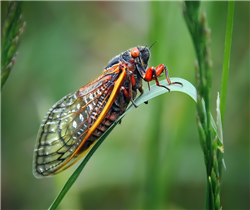 For first time in 221 years, two cicada broods to emerge in Indiana simultaneously, The Indianapolis Star: Cicadas are buzzing back to Indiana in 2024, and in a big way say bug experts.
For first time in 221 years, two cicada broods to emerge in Indiana simultaneously, The Indianapolis Star: Cicadas are buzzing back to Indiana in 2024, and in a big way say bug experts.
For the first time in 221 years, two different broods of cicadas — the 17-year Brood XIII and the 13-year Brood XIX — will appear in parts of Indiana and other states. A dual emergence is rare, according to Dr. Gene Kritsky of Cincinnati’s Mount St. Joseph University.
The last time two broods of cicadas emerged at once in Indiana, the year was 1803 and Thomas Jefferson was President. Different broods of cicadas have popped up in other states, however, such as Missouri in 1998, or when rock album “Windows from Heaven” was released by Jefferson Starship.
Here’s what we know about this unique, natural event happening in Indiana and large swaths of the Midwest.
How often do cicadas appear in Indiana?
While annual cicadas appear every 2-5 years, broods of periodical cicadas will emerge once every 17 years across the Hoosier state. There are two broods, however, that emerge every 13 years, according to Purdue University.
These black-bodied, red-eyed, winged insects crawl out of the ground from around late May to June to reproduce and begin their life-cycle anew. Cicadas can be found on every continent except Antarctica. There are more than 3,000 different species of cicadas around the world, according to the Indiana Department of Natural Resources.
Brood XIII (17-year brood) cicadas are coming to the Midwest in 2024
Brood XIII cicadas will emerge in parts of Indiana, Iowa, Wisconsin and possibly Michigan, according to CicadaMania.org, but are expected to be concentrated in Illinois. These cicadas last emerged in 2007.
This year, cicadas in Illinois will create some unique challenges for entomologists, according to the University of Connecticut. The Prairie State is home to both the 17- and 13-year cicada broods.
Where will Brood XIII cicadas appear in Indiana in 2024?
In 2024, Brood XIII cicadas will appear in areas of Lake, LaPorte, and Porter counties in the upper northwestern side of Indiana, according to Purdue University.
Do cicadas bite?
Cicadas might look scary with their red eyes, huge wings and prickly feet, but they’re harmless to humans.
They don’t sting or carry diseases, and they don’t bite. In fact, cicadas don’t have mouth parts that can bite, said Elizabeth Barnes, an entomologist with Purdue University in a previous article by IndyStar.
No, they won’t bite: Debunking 8 common myths about cicadas
What about the other species of cicadas? Where will Brood XIX (13-year brood) cicadas appear?
This year the Brood XIX cicadas are set to emerge in 15 states across the country. They’ll appear in Alabama, Arkansas, Georgia, Illinois, Indiana, Kentucky, Louisiana, Missouri, Mississippi, North Carolina, Oklahoma, South Carolina and Virginia.
Where will Brood XIX cicadas appear in Indiana in 2024?
In 2024, the 13-year Brood XIX cicadas will appear in 8 western counties across the Hoosier State, according to Purdue University, from Posey and Warrick counties near Evansville in the south, to Newton and Jasper counties on the north.
To see the full story and video please visit the IndyStar.
Resources:
Periodical Cicadas, Indiana Department of Natural Resources, Division of Entomology
Billions of Cicadas Are Coming This Spring; What Does That Mean for Wildlife?, Got Nature? Blog, Purdue Extension-Forestry and Natural Resources (FNR)
17 Ways to Make the Most of the 17-year Cicada Emergence, Purdue College of Agriculture
Ask an Expert: Cicada Emergence Video, Got Nature? Blog, Purdue Extension-FNR
Periodical Cicada in Indiana, The Education Store, Purdue Extension resource center
Cicada Killers, The Education Store
Purdue Cicada Tracker, Purdue Extension-Master Gardener Program
Cicada, Youth and Entomology, Purdue Extension
Indiana Department of Entomology and Plant Pathology
Tim Gibb, Insect Diagnostician and Extension Specialist
Purdue Department of Entomology
Wild Bulletin, Indiana Department of Natural Resources (DNR) Fish and Wildlife: Did you know that wild game shot with lead ammunition can sometimes contain lead fragments all the way to the dinner table? Adopting different shot placement and butchering techniques can help alleviate the problem.
When shooting: Avoid shooting animals in heavily boned areas, such as the front shoulders, as this is more likely to cause bullet fragmentation. Instead, shoot animals in softer tissue, such as around the heart and lungs, to decrease fragmentation.
When butchering: Carefully observe the wound channel in the animal and generously trim away any meat that shows bullet trauma. This will help keep fragments out of your finished meat product. Properly dispose of your trimmed meat by sending it to the local landfill or burying it on private property.
Looking for another way for you and your family to avoid ingesting lead fragments? Talk to your local retailer about finding a nontoxic ammunition that’s right for you.
To learn more please visit DNR: Effects of lead on wildlife.
Resources:
Hunting Guide for 2023-2024, Indiana Department of Natural Resources
How to Score Your White-tailed Deer, video, The Education Store, Purdue Extension Resource Center
White-Tailed Deer Post Harvest Collection, video, The Education Store
Age Determination in White-tailed Deer, video, The Education Store
How to Build a Plastic Mesh Deer Exclusion Fence, The Education Store
Managing Your Woods for White-Tailed Deer, The Education Store
Bovine Tuberculosis in Wild White-tailed Deer, The Education Store
Help With Wild Turkey Populations, Video, Purdue Extension – Forestry and Natural Resources YouTube Channel
Turkey Brood Reporting, Indiana Department of Natural Resources (IDNR)
Wild Turkey, Indiana Department of Natural Resources (IDNR)
Wild Turkey Hunting Biology and Management, Indian Department of Natural Resources (IDNR)
Subscribe to Purdue Extension-Forestry & Natural Resources YouTube Channel, Wildlife Playlist
Indiana Department of Natural Resources
Recent Posts
- Researchers Study Deer-Vehicle Collision Reduction Method
Posted: July 31, 2024 in Safety, Wildlife - MyDNR – First positive case of chronic wasting disease in Indiana
Posted: April 29, 2024 in Alert, Disease, How To, Safety, Wildlife - Cicadas in Spring! – Purdue Landscape Report
Posted: April 9, 2024 in Forestry, Plants, Safety, Wildlife - New Deer Impact Toolbox
Posted: April 7, 2024 in Forestry, Land Use, Plants, Publication, Safety, Wildlife, Woodlands - Help Research Chronic Wasting Disease – Wild Bulletin
Posted: April 3, 2024 in Disease, Forestry, How To, Safety, Wildlife, Woodlands - How to Interact with Young Wildlife This Spring, MyDNR
Posted: March 28, 2024 in Forestry, How To, Safety, Wildlife, Woodlands - Rare Cicada Emergence: Q&A with Purdue Bug Expert
Posted: March 25, 2024 in Alert, Forestry, Plants, Safety, Wildlife - Barn Owls in Goose Pond Fish & Wildlife Area Nest Box, MyDNR
Posted: March 4, 2024 in Forestry, Land Use, Safety, Wildlife, Woodlands - Cicadas Are Making a Rare Appearance in Indiana in 2024, Indy Star
Posted: January 20, 2024 in Forestry, Plants, Safety, Wildlife - Learn About Lead: Avoiding Lead Ingestion in Wild Game, Wild Bulletin
Posted: December 8, 2023 in Alert, Disease, How To, Safety, Wildlife
Archives
Categories
- Alert
- Aquaculture/Fish
- Aquatic/Aquaculture Resources
- Ask the Expert
- Christmas Trees
- Community Development
- Disease
- Drought
- Forestry
- Forests and Street Trees
- Gardening
- Got Nature for Kids
- Great Lakes
- How To
- Invasive Animal Species
- Invasive Insects
- Invasive Plant Species
- Land Use
- Natural Resource Planning
- Nature of Teaching
- Plants
- Podcasts
- Ponds
- Publication
- Safety
- Spiders
- Timber Marketing
- Uncategorized
- Urban Forestry
- Webinar
- Wildlife
- Wood Products/Manufacturing
- Woodland Management Moment
- Woodlands

